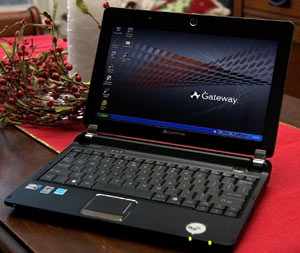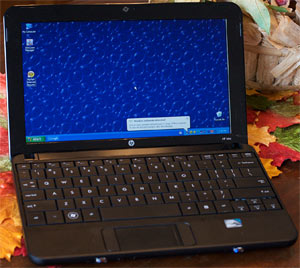Gifts of Christmas 2009: 3G Netbooks
Netbooks are all the rage: they are lightweight, compact and relatively capable computers that generally weigh in at a few hundred dollars. Could one be the perfect Christmas gift for the technology loving person on your shopping list this holiday? Recently, we were able to spend some time with two of Verizon’s 3G enabled netbooks to see how they stacked up.
The two machines we looked at were the HP Mini 110 and Gateway LT2016u. Both machines are equipped with a 10.1” display, Intel’s 1.6 GHz Atom processor, 1 GB of RAM and Windows XP Home Edition. The HP weighs in at about 2.5 lbs., the Gateway a half a pound heavier.
For low-end machines, both netbooks are well built. Under Verizon’s subsidies, the HP sells for $150 and the Gateway, $99. However, keeping in mind that the units go for $500 and $600, respectively, when unsubsidized helps explain how the manufacturers pack a decent system into a low priced package.
The subsidy the carrier is paying to HP or Gateway, along with a relatively modest processor and accompanying components, has the benefit that the systems feel like they have a better construction than low-end full sized laptops. Often a $400-$600 13” or 15” system will have better internal components, but a flimsy design that degrades the overall experience. That is to say, netbooks such as those we looked at are probably more fairly pitted against a $700 or $800 machine in build quality, even if a $400 laptop has a better processor or more RAM. Faster processors put into a really cheap chassis will not necessary lead to a great end result on a laptop.
Externally, the HP is – in our subjective judgment – a somewhat more attractive design. Following other HP’s present trend of Apple-inspired design, the Mini 110 uses a sunken hinge that keeps the bezel around the screen somewhat less intrusive and creates a clean, solid look when the netbook is closed. If the unit were glossy white rather than black, one might be inclined to mistake it for a MacBook’s little brother.
 |
|
The Gateway LT2016u. |
The Gateway is somewhat less aesthetically pleasing on the outside, although certainly pleasant enough. The biggest disadvantage with the Gateway’s design is that the battery protrudes from the rear of the unit. On the other hand, Gateway makes use of this design element to provide a slightly more comfortable angle for the typing surface and vastly superior battery life.
Exterior design is the only area where we felt the HP held some advantage over the Gateway. Upon actually powering up the systems, the Gateway’s glossy screen provides a harbinger of its advantage over the HP, sporting richer, more saturated colors that were much closer to those of a higher end notebook.
One of the biggest usability differences we found between the systems concerned the keyboard and trackpad. While the Gateway opted for traditional, slightly indented keys on the keyboard that were surprisingly comfortable for the size, we found the flat-faced keys of the HP made touch-typing more difficult. We were also somewhat unsure of the HP’s trackpad, which positions the left and right mouse buttons on the sides of the trackpad rather than below it. Disappointingly, we found neither trackpad’s scrolling function was particularly easy to use. On the other hand, very few Windows-based laptops offer easy scrolling, so it is hard to fault the netbooks too much on that issue.
Software-wise, the systems are relatively similar, given that both use Windows XP. Our HP’s sibling, the Mini 311, includes Windows 7 – likely a worthy $50 upgrade, considering the system also sports more RAM and a more traditional trackpad.
If you are a Windows user, there is very little not to like about having a miniature Windows system to tag along on travels. Keep in mind, however, that these are not maintenance free smartphones writ large; security measures such as antivirus software is necessary on Windows-based netbooks. In the future, we hope Verizon picks up one of HP’s (or another OEM’s) netbook-optimized Linux distributions as an alternative to Windows – or, perhaps Google’s Chrome OS Linux adaptation, which is expected to be released next year.
We were impressed that the HP included a lightweight file synchronization program, Syncables Desktop, for mirroring various items with one’s full sized computer. Using such a sync program or an online storage and sync tool, such as Dropbox or SpiderOak, will help to keep one’s current projects from one’s main computer at hand while commuting or traveling with the netbook.
We would like to see Verizon work with HP, Gateway and any other OEMs it utilizes to better integrate VZAccess Manager with the manufacturers’ and Microsoft’s wireless access controls. At times we had no less than three Wi-Fi and WWAN programs popping up messages and attempting to control the network interfaces. Generally, these tools duplicated each other’s functionality, muddying the waters as to what should be used when.
One of the nicest things about netbooks such as these is that they are so easy to keep handy. Unlike larger laptops, 10” netbooks can be easily stashed on a bookshelf nearby, on a nightstand, in a purse, or other convenient place with very little thought. While the difference between a 10” and 13” system may not seem like much, in reality, the diminutive netbook really is easier to find places to store and carry.
 |
|
The Hewlett-Packard Mini 110. |
Performance on these systems is average for a netbook-class machine. Our usual cautions that go with netbooks are fitting here. To put things into perspective, in our suite of benchmarks, we found that average CPU performance was roughly one sixth of a base Unibody MacBook (Core 2 Duo 2.26 GHz) and OpenGL graphics performance was as low as one sixteenth of the MacBook, which has been offered for as low as $800 after mail-in rebates this Christmas season. While the systems are still quite capable at basic tasks such as web surfing and e-mail, performance constraints – which are true of netbooks in general – are worth keeping in mind when looking at these systems.
Head-to-head, the Gateway beat the HP in every benchmark. In single threaded tests, the Gateway was up to 16% faster than the HP. In multithreaded tests, the HP performed somewhat better, about 95% of the speed of the Gateway. The Gateway also bested the HP on OpenGL performance, though easily within the margin of error.
Who are these devices made for? While these 3G-enabled netbooks are even cheaper than their Wi-Fi only brethren, they come with two-year contracts that ring up at a minimum of $40/month (and we think the $60/month plan is more practical). This certainly narrows the target audience and, of course, puts a few hurdles on gifting one of these machines. These systems are not made for everyone; yet, if you can get over the price of admission, there is little doubt that these little systems are very handy.
These devices are perfect for the busy traveler or frequent commuter who would happily skip the espresso for the bliss of always available Internet connectivity in a small, easy to tote package. In particular, this sort of device seems like it is tailor-made for the mass transit commuter or frequent flyer for whom a larger laptop simply would not fit conveniently.
On the other hand, if one has multiple Wi-Fi devices that would benefit from using a 3G cellular connection, we would suggest the Mi-Fi as our favorite broadband option at the present time. The tiny, sleek $49 Mi-Fi uses the same $40 or $60 broadband plans on Verizon’s network, but can share access with up to five Wi-Fi enabled devices at any given time. This means the whole family, and not just the person with the 3G-enabled laptop, can enjoy excellent broadband connective.
Caveats aside, for those that have need of a compact Internet access device that is a full PC and not just a smartphone, both the HP Mini 110 and Gateway LT2016u are fine units. Given its lower price tag and superior performance, we commend the Gateway, in particular (Gateway/Verizon, $99 with 2 year contract, www.vzw.com; HP/Verizon, $149 with 2 year contract, www.vzw.com).
Join the Conversation
Pingback: Twitter Trackbacks for Gifts of Christmas 2009: 3G Netbooks - OFB.biz: Open for Business [ofb.biz] on Topsy.com
n”>